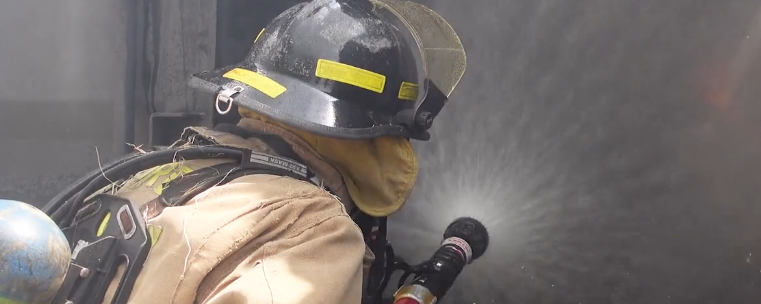Indirect
- By remotely injecting a fog stream into an unoccupied compartment that has been on fire for a brief period of time, the stream converts to steam, and the steam extinguishes the fire.
- There can be no life hazard within the compartment, including firefighters.
- The ceiling temperature must have reached at least 1,000°F.
- The water fog must be injected from outside the compartment.
- The fog stream should be held in a fixed position and aimed at the ceiling area.
- Ventilation should be avoided to allow the steam to do its work.
Combination
- Rotate the fog stream in a clockwise fashion after injection into the compartment from the outside.
- The clockwise rotation pushes the products of combustion and steam away from the nozzle operator.
- A counterclockwise motion draws the products toward the nozzle operator.
Direct
- This is the application of a fire stream directly onto the burning fuel. It is typically used when the fire is in the incipient, or, growth stage.
Modified direct
- This is a two-step attack.
- Step 1: A solid or straight stream is directed into the heated overhead of the fire area. The nozzle is moved in an approved pattern, splattering the stream against the ceiling and upper walls.
- This allows the stream to be broken up into smaller droplets that can absorb the heat and will rain down onto the burning objects.
- Step 2- The stream is then directed onto the burning objects in a direct application to achieve knockdown and extinguishment.
- Step 1: A solid or straight stream is directed into the heated overhead of the fire area. The nozzle is moved in an approved pattern, splattering the stream against the ceiling and upper walls.
Blitz
- This attack is a very rapid application of large quantities of water immediately on arrival of the engine. This uses water from the engine’s tank, which is applied from a distance. The time-consuming effort of laying a supply line is sacrificed for the benefit of getting water on the fire soon after arrival.
Transitional attack
- The transitional attack is used only when fire is issuing from the structure, not when the fire is contained to the compartment. The transitional attack is an exterior attack that uses a hand line, applying water through an opening (typically a window) directly into the fire compartment. The goal is to reduce the temperatures in the fire compartment, while hand lines are being deployed to attack the fire using a direct or modified direct attack. The transitional attack “resets” the fire to an earlier stage. It is important to point out the transitional attack does not take the place of an interior attack.


